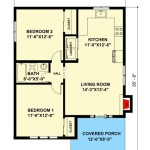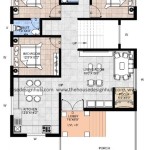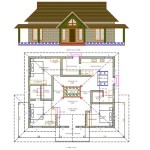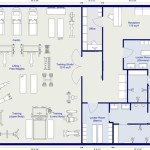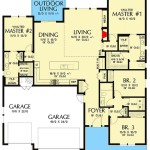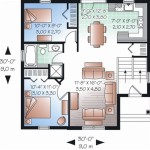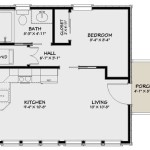Rectangle House Plans Two Story: Maximizing Space and Efficiency
Rectangle house plans with two stories offer a compelling solution for homeowners seeking efficient and cost-effective designs. The simplicity of the rectangular form, combined with the vertical expansion of a two-story structure, allows for a versatile range of interior layouts and exterior architectural styles. This article will delve into the advantages, considerations, and popular design elements associated with rectangle house plans featuring two stories, offering a comprehensive overview for those considering this building approach.
The inherent efficiency of a rectangular footprint lies in its minimal perimeter-to-area ratio. This translates to reduced material costs during construction, as less exterior wall surface is required to enclose a given square footage compared to more complex shapes. Furthermore, the simplified geometry lends itself to faster and less complicated construction processes, potentially leading to savings in labor costs as well. The two-story arrangement further enhances the efficiency, stacking living spaces vertically to minimize the land footprint. This is particularly beneficial in areas with limited lot sizes or high land costs.
Beyond cost savings, rectangular two-story homes offer flexibility in design. The interior spaces can be easily divided and configured to meet diverse lifestyle needs. Whether seeking open-concept living areas or more defined, compartmentalized spaces, the rectangular form provides a neutral canvas upon which to implement various design strategies. The two-story configuration also allows for a clear separation between living areas and sleeping quarters, providing a degree of privacy often desired in modern homes.
Optimizing Space and Layout
One of the key considerations when designing a rectangular two-story house plan is maximizing the usability of interior space. Careful attention should be paid to the placement of staircases, hallways, and other circulation routes to minimize wasted square footage. Strategically positioning these elements can significantly impact the overall flow and functionality of the home.
Open-concept designs are particularly well-suited to rectangular layouts. By removing interior walls between living, dining, and kitchen areas, a sense of spaciousness and connectivity can be achieved. This approach also promotes natural light penetration throughout the main living areas. However, it's important to consider acoustics and visual separation when implementing an open-concept design. Strategic placement of furniture, rugs, and architectural features can help define zones within the open space.
In terms of bedroom placement, the second story of a rectangular home typically houses the sleeping quarters. This arrangement provides a natural separation from the more active living areas on the ground floor, enhancing privacy and creating a quieter environment for rest. Master suites are often positioned at one end of the second story to maximize privacy and offer desirable features such as walk-in closets and ensuite bathrooms. Secondary bedrooms can be arranged along a hallway or in a grouping, depending on the desired layout and family needs.
The placement of bathrooms and utility areas is equally crucial for efficient space utilization. Minimizing plumbing runs can reduce construction costs and improve water efficiency. Stacking bathrooms on top of each other on different floors can streamline plumbing infrastructure. Locating laundry rooms near bedrooms is another practical consideration, reducing the distance required to transport laundry.
Architectural Styles and Exterior Design
The simple geometry of a rectangular two-story house plan provides a versatile foundation for a wide range of architectural styles. From traditional to contemporary, the exterior design can be tailored to reflect personal preferences and complement the surrounding environment. The roofline plays a significant role in defining the overall aesthetic of the home.
Gabled roofs are a common and cost-effective choice for rectangular homes. Their simple design allows for efficient water runoff and provides ample attic space for storage or future expansion. Hipped roofs, with slopes on all four sides, offer a more sophisticated and visually appealing alternative. Flat roofs, while often associated with modern architecture, can also be incorporated into rectangular designs, particularly when combined with parapet walls to conceal the roof structure. The choice of roofing material, such as asphalt shingles, metal roofing, or tile, further contributes to the overall style and durability of the home.
The exterior cladding material is another key element in defining the architectural style. Brick, stone, siding, and stucco are all popular choices, each offering unique aesthetic qualities and performance characteristics. Brick and stone lend a traditional and durable feel, while siding and stucco provide a more contemporary and cost-effective option. The choice of windows and doors also plays a crucial role in the overall design. Large windows can bring in ample natural light and offer panoramic views, while smaller windows can provide privacy and energy efficiency.
The landscaping surrounding a rectangular two-story home can further enhance its curb appeal and integrate it into the natural environment. Well-designed landscaping can soften the sharp edges of the rectangular form and create a welcoming and inviting atmosphere. Trees, shrubs, and flowers can be strategically placed to frame the house, provide shade, and add color and texture to the exterior.
Energy Efficiency and Sustainability
Designing a rectangular two-story home with energy efficiency and sustainability in mind is becoming increasingly important. The inherent simplicity of the rectangular form lends itself well to energy-efficient construction practices. By minimizing the exterior surface area, heat loss and gain can be reduced, leading to lower energy bills and a smaller environmental footprint.
Proper insulation is crucial for maintaining a comfortable indoor temperature and reducing energy consumption. Insulating walls, roofs, and floors with high-performance materials can significantly reduce heat transfer. Air sealing is equally important to prevent drafts and air leaks, which can compromise the effectiveness of insulation. Selecting energy-efficient windows and doors with low-e coatings and insulated frames can further minimize heat loss and gain.
The orientation of the house on the lot can also impact its energy efficiency. Orienting the house with the long axis facing south can maximize solar gain in the winter, reducing heating costs. Overhanging eaves and awnings can provide shade in the summer, preventing excessive heat gain. Planting trees strategically around the house can also provide shade and reduce the need for air conditioning.
Integrating renewable energy systems, such as solar panels, can further reduce the environmental impact of a rectangular two-story home. Solar panels can generate electricity or heat water, reducing reliance on fossil fuels. Rainwater harvesting systems can collect rainwater for irrigation and other non-potable uses, conserving water resources. Using sustainable building materials, such as recycled content products and locally sourced lumber, can further reduce the environmental footprint of the construction process.
The design of a rectangular two-story home provides a practical and versatile foundation for creating efficient, stylish, and sustainable living spaces. By carefully considering space optimization, architectural style, and energy efficiency, homeowners can create a home that meets their needs and reflects their personal preferences. The inherent simplicity of the rectangular form, combined with the vertical expansion of a two-story structure, offers a compelling alternative to more complex and costly building approaches.
Future Adaptability and Renovation Potential
A crucial, often overlooked aspect of home design is its potential for future adaptation and renovation. Rectangular two-story house plans inherently lend themselves to flexibility in the long term. The straightforward layout and structural design often simplify future modifications and extensions, allowing homeowners to adapt their living spaces to changing needs and preferences.
The relatively simple load-bearing structure of a rectangular home simplifies the process of adding extensions or rearranging interior walls. This contrasts sharply with more complex architectural designs that often pose significant challenges and costs when undergoing modifications. The regularity of the wall structures and the predictable load paths make engineering calculations and construction processes more straightforward.
The stacking of spaces in a two-story design allows for vertical expansion possibilities, given appropriate zoning regulations and structural considerations. Adding a third story or finishing an attic space can significantly increase living area without expanding the ground footprint. Similarly, basements in rectangular homes often offer untapped potential for creating additional living spaces, such as recreation rooms, home offices, or guest suites.
Interior renovations are also often simplified in rectangular homes. The consistent spacing of studs and joists makes it easier to run electrical wiring and plumbing lines, reducing the complexity and cost of these aspects of renovation projects. The rectangular shape also facilitates the installation of modular components, such as kitchen cabinets and bathroom fixtures, streamlining the renovation process.

2 Story Rectangular Floor Plans Open

Two Story Floor Plans Kintner Modular Homes Builder Pennsylvania Custom Home Contractor

2 Story Rectangular Floor Plans

2 Story House Plans Small Mansion Farmhouse Modern More Blog Floorplans Com

Pin Page

Pin Page

Joseph Houes Plan Two Story Rear Garage Narrow With 4 Bedrooms Home Design Mm 2185 C

Rectangular House Plan With Flex Room On Main And Upstairs Laundry 50184ph Architectural Designs Plans

Pin Page

Simple Narrow Lot House Plans Houseplans Blog Com

